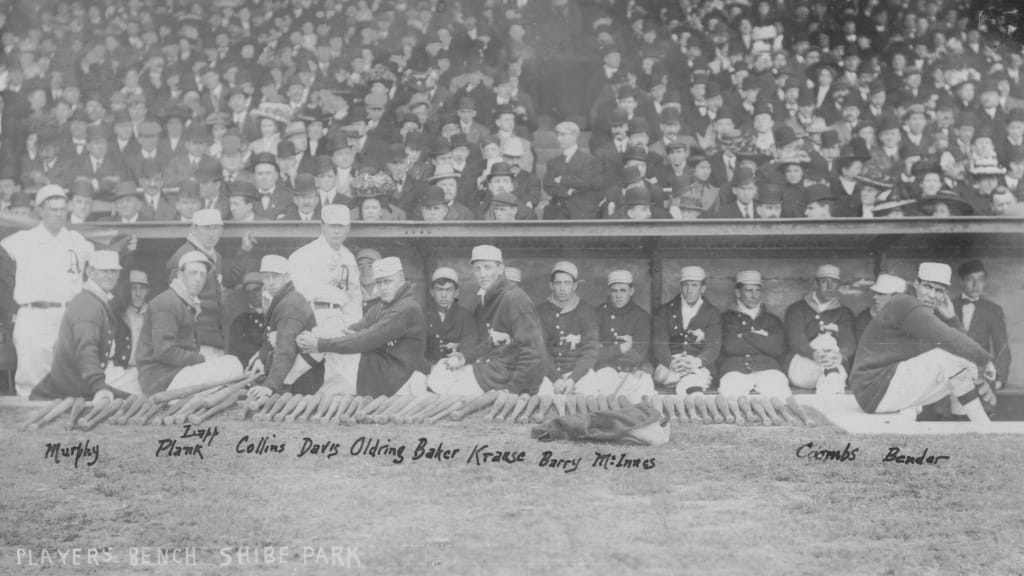
Shibe Park opened on April 12, 1909, as the new home of the American League's Philadelphia Athletics. It was located at 21st Street and Lehigh Avenue, five blocks west of Baker Bowl where the Phillies played. Named Shibe Park after the owner of the A's, Ben Shibe, it was renamed Connie Mack Stadium in 1953 in honor of the long-time A's manager (1901-50).
The A's were a charter member of the AL when it was founded (1901). Columbia Park was their first home. With success on the field and at the gate, the A's out-grew the 6,500-seat park. Shibe decided to build his own home.
It was the first one built with a new technology of steel-reinforced concrete. It took one year to build, a cost of just over $300,000. It had a seating capacity of 23,000. The dimensions were 378 feet to left field, 515 feet to center field and 340 feet to right field. A double-decked grandstand wrapped around the infield with open pavilion seating extending to both foul poles. There were no seats in the outfield.
The largest baseball crowd in Philadelphia history was there for the opener. Tickets quickly sold out. Gates were closed, but estimates of another 15,000 angry fans were on the outside. Some stormed through a gate. Police were called to control the mob. An estimated 7,000 fans wound up standing behind ropes in the outfield. Attendance, 30,162. Residents on 20th Street sold tickets on their rooftops and second-floor windows.
The outcome of the game seemed to take a back seat to the chaos of the day. The A's won, 8-1, over the Boston Red Sox. Left-hander Eddie Plank tossed a complete game. A's third baseman Simon Nicholls registered the first hit with a single.
The A's last game there was September 19, 1954, a 4-2 loss to the New York Yankees. Attendance was a mere 1,715. The A's were sold and moved to Kansas City following that season, leaving the Phillies as the sole tenant. The Phillies moved out of a dilapidated Baker Bowl permanently on July 4, 1938. They first played 11 games there in 1927 while repairs were being made following a grandstand collapse at Baker Bowl.
Postgame chaos marred the ballpark's final game on Oct. 1, 1970, a 2-1 Phillies win over the Montreal Expos in 10 innings. Attendance, 31,822. As soon as Tim McCarver scored the winning run, fans stormed the field. They tore up sections of grass, ripped boards off the left-field wall, scooped up dirt, carried out urinals, seats, signs and tried to dig up home plate. Security won that battle. One fan was seen leaving with a toilet seat around his neck. Sixty-one years of baseball at 21st and Lehigh ended ingloriously.
Numerous changes were made to Shibe Park over time. Permanent seating was added in left field (1913); remaining grandstands not double-decked, were doubled and the main grandstand was rebuilt ('25). A mezzanine was added (1929-30). Capacity increased to 33,000.
The original right-field fence was 12 feet high until the A's added a 22-foot corrugated metal extension that blocked the view of 20th street residents (1935). Residents sued to have the "Spite Wall" removed but lost. Four years later, the A's installed eight 146-foot light towers creating another issue with neighbors. The league's first night game was played on May 16, 1939, an 8-3, 10-inning loss to Cleveland. Attendance: 15,109.
The park hosted eight World Series, seven for A's (1910-11, '13, '14, 1929-30-31), one for the Phillies ('50) and two All-Star Games ('43 and '52). Nine Hall of Famers from the A's and three from the Phillies called the field their home. Four A's pitchers tossed no-hitters; Phillies pitchers, none. The A's had only three managers, Mack (50 years, 7,466 games), Jimmy Dykes (three seasons) and Eddie Joost (final season). A total of 6,047 games were played there; attendance totaled over 47 million.
The abandoned facility became rat-infested. Tall weeds replaced the grass playing field. Finally, after several fires, demolition took place in 1976. It remained a large vacant plot until '90, when the Deliverance Evangelistic Church was built.

